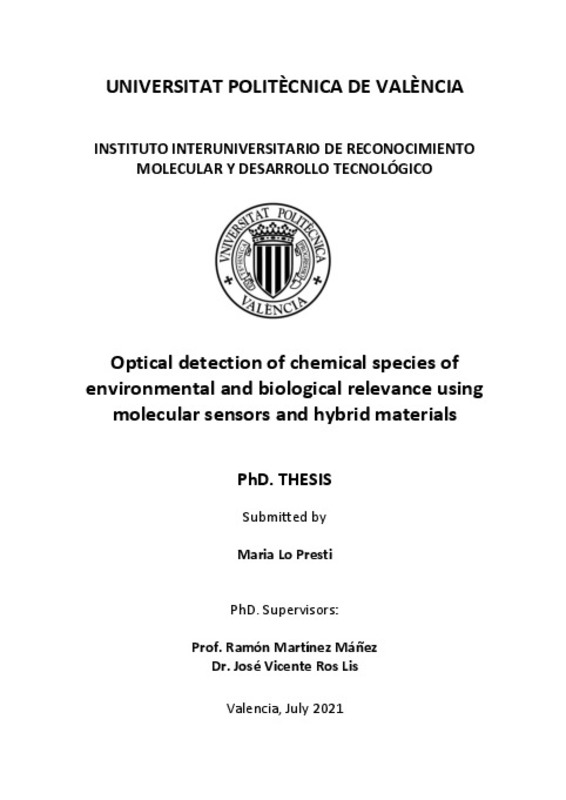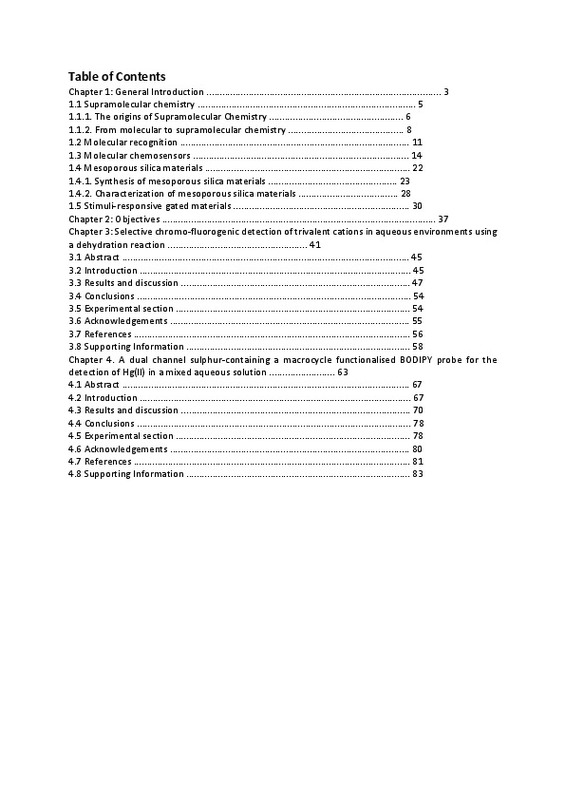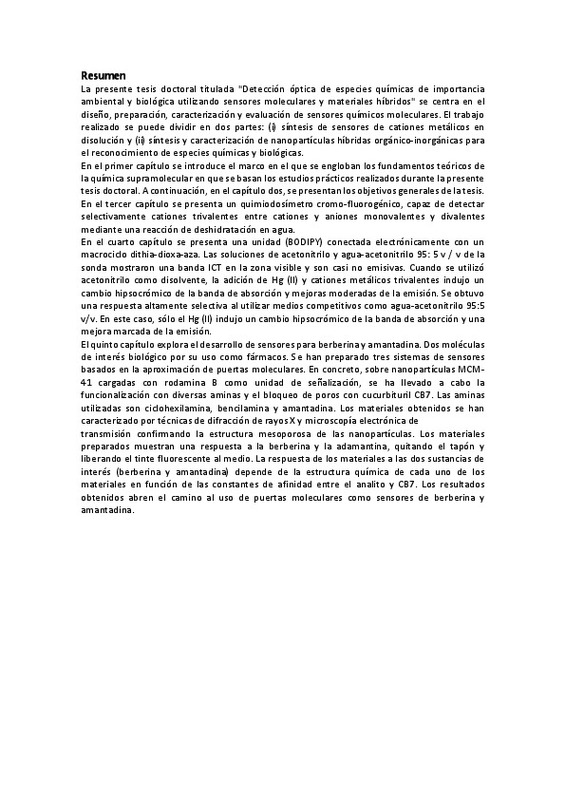- RiuNet repositorio UPV
- :
- Investigación
- :
- Tesis doctorales
- :
- Ver ítem
JavaScript is disabled for your browser. Some features of this site may not work without it.
Buscar en RiuNet
Listar
Mi cuenta
Estadísticas
Ayuda RiuNet
Admin. UPV
Optical detection of chemical species of environmental and biological relevance using molecular sensors and hybrid materials
Mostrar el registro sencillo del ítem
Ficheros en el ítem
| dc.contributor.advisor | Martínez Mañez, Ramón
|
es_ES |
| dc.contributor.advisor | Ros Lis, José Vicente
|
es_ES |
| dc.contributor.author | Lo Presti, Maria
|
es_ES |
| dc.date.accessioned | 2021-09-17T06:14:43Z | |
| dc.date.available | 2021-09-17T06:14:43Z | |
| dc.date.created | 2021-07-30 | |
| dc.date.issued | 2021-09-02 | es_ES |
| dc.identifier.uri | http://hdl.handle.net/10251/172664 | |
| dc.description.abstract | [ES] La presente tesis doctoral titulada "Detección óptica de especies químicas de importancia ambiental y biológica utilizando sensores moleculares y materiales híbridos" se centra en el diseño, preparación, caracterización y evaluación de sensores químicos moleculares. El trabajo realizado se puede dividir en dos partes: (i) síntesis de sensores de cationes metálicos en disolución y (ii) síntesis y caracterización de nanopartículas híbridas orgánico-inorgánicas para el reconocimiento de especies químicas y biológicas. En el primer capítulo se introduce el marco en el que se engloban los fundamentos teóricos de la química supramolecular en que se basan los estudios prácticos realizados durante la presente tesis doctoral. A continuación, en el capítulo dos, se presentan los objetivos generales de la tesis. En el tercer capítulo se presenta un quimiodosímetro cromo-fluorogénico, capaz de detectar selectivamente cationes trivalentes entre cationes y aniones monovalentes y divalentes mediante una reacción de deshidratación en agua. En el cuarto capítulo se presenta una unidad (BODIPY) conectada electrónicamente con un macrociclo dithia-dioxa-aza. Las soluciones de acetonitrilo y agua-acetonitrilo 95: 5 v / v de la sonda mostraron una banda ICT en la zona visible y son casi no emisivas. Cuando se utilizó acetonitrilo como disolvente, la adición de Hg (II) y cationes metálicos trivalentes indujo un cambio hipsocrómico de la banda de absorción y mejoras moderadas de la emisión. Se obtuvo una respuesta altamente selectiva al utilizar medios competitivos como agua-acetonitrilo 95:5 v/v. En este caso, sólo el Hg (II) indujo un cambio hipsocrómico de la banda de absorción y una mejora marcada de la emisión. El quinto capítulo explora el desarrollo de sensores para berberina y amantadina. Dos moléculas de interés biológico por su uso como fármacos. Se han preparado tres sistemas de sensores basados en la aproximación de puertas moleculares. En concreto, sobre nanopartículas MCM-41 cargadas con rodamina B como unidad de señalización, se ha llevado a cabo la funcionalización con diversas aminas y el bloqueo de poros con cucurbituril CB7. Las aminas utilizadas son ii ciclohexilamina, bencilamina y amantadina. Los materiales obtenidos se han caracterizado por técnicas de difracción de rayos X y microscopía electrónica de transmisión confirmando la estructura mesoporosa de las nanopartículas. Los materiales preparados muestran una respuesta a la berberina y la adamantina, quitando el tapón y liberando el tinte fluorescente al medio. La respuesta de los materiales a las dos sustancias de interés (berberina y amantadina) depende de la estructura química de cada uno de los materiales en función de las constantes de afinidad entre el analito y CB7. Los resultados obtenidos abren el camino al uso de puertas moleculares como sensores de berberina y amantadina. | es_ES |
| dc.description.abstract | [CA] La present tesi doctoral titulada "Detecció òptica d'espècies químiques d'importància ambiental i biològica utilitzant sensors moleculars i materials híbrids" se centra en el disseny, preparació, caracterització i avaluació de sensors químics moleculars. El treball realitzat es pot dividir en dues parts: (i) síntesi de sensors de cations metàl·lics en dissolució i (ii) síntesi i caracterització de nanopartícules híbrides orgànic-inorgànics per al reconeixement d'espècies químiques i biològiques. En el primer capítol s'introdueix el marc en el qual s'engloben els fonaments teòrics de la química supramolecular en què es basen els estudis pràctics realitzats durant la present tesi doctoral. A continuació, en el capítol dos, es presenten els objectius generals de la tesi. En el tercer capítol es presenta un quimiodosímetro crom-fluorogénic, capaç de detectar selectivament cations trivalents entre cations i anions monovalents i divalents mitjançant una reacció de deshidratació en aigua. En el quart capítol es presenta una unitat (BODIPY) connectada electrònicament amb un macrocicle dithia-dioxa-aza. Les solucions de acetonitril i aigua-acetonitril 95:5 v/v de la sonda van mostrar una banda ICT a la zona visible i són gairebé no emisivas. Quan es va utilitzar acetonitril com a dissolvent, l'addició de Hg (II) i cations metàl·lics trivalents va induir un canvi hipsocròmic de la banda d'absorció i millores moderades de l'emissió. Es va obtenir una resposta altament selectiva a l'utilitzar mitjans competitius com aigua-acetonitril 95:5 v/v. En aquest cas, només el Hg (II) va induir un canvi hipsocròmic de la banda d'absorció i una millora marcada de l'emissió. El cinquè capítol explora el desenvolupament de sensors per berberina i amantadina. Dues molècules d'interès biològic pel seu ús com a fàrmacs. S'han preparat tres sistemes de sensors basats en l'aproximació de portes moleculars. En concret, sobre nanopartícules MCM-41 carregades amb rodamina B com a unitat de senyalització, s'ha dut a terme la funcionalització amb diverses amines i el bloqueig de porus amb cucurbituril CB7. Les amines utilitzades són ciclohexilamina, bencilamina i amantadina. Els materials obtinguts s'han caracteritzat per tècniques iv de difracció de raigs X i microscòpia electrònica de transmissió confirmant l'estructura mesoporosa de les nanopartícules. Els materials preparats mostren una resposta a la berberina i la adamantina, llevant el tap i alliberant el tint fluorescent a l'mig. La resposta dels materials a les dues substàncies d'interès (berberina i amantadina) depèn de l'estructura química de cada un dels materials en funció de les constants d'afinitat entre l'anàlit i CB7. Els resultats obtinguts obren el camí a l'ús de portes moleculars com a sensors de berberina i amantadina. | es_ES |
| dc.description.abstract | [EN] The present doctoral thesis entitled "Optical detection of chemical species of environmental and biological importance using molecular sensors and hybrid materials" focuses on the design, preparation, characterization and evaluation of molecular chemical sensors. The work carried out can be divided into two parts: (i) synthesis of metal cation sensors in solution and (ii) synthesis and characterization of hybrid organic-inorganic nanoparticles for the recognition of chemical and biological species. The first chapter introduces the framework that encompasses the theoretical foundations of supramolecular chemistry on which the practical studies carried out during this doctoral thesis are based. Next, in chapter two, the general objectives of the thesis are presented. In the third chapter, a chromium-fluorogenic chemodosimeter is presented, capable of selectively detecting trivalent cations by means of a dehydration reaction in water. The fourth chapter presents a new compound containing a BODIPY unit electronically connected with a dithia-dioxa-aza macrocycle. Acetonitrile and water-acetonitrile 95:5 v/v solutions of the probe showed an ICT band in the visible zone and were nearly non-emissive. When acetonitrile was used as a solvent, addition of Hg(II) and trivalent metal cations induced an hypsochromic shift of the absorption band and moderate emission enhancements. A highly selective response was obtained when using competitive media such as water- acetonitrile 95:5 v/v. In this case only Hg(II) induced a hypsochromic shift of the absorption band and a marked emission enhancement. The fifth chapter explores the development of sensors for berberine and amantadine; two molecules of biological interest due to their use as drugs. Three sensing systems based on a "molecular gate" approximation have been prepared. Specifically, MCM-41 nanoparticles were loaded with Rhodamine B as a signalling unit, functionalized with various amines and capped with cucurbituril CB7. The amines used are cyclohexylamine, benzylamine and amantadine., The materials obtained were characterized by X-ray diffraction techniques and transmission vi electron microscopy, confirming the mesoporous structure of the nanoparticles. The prepared materials showed a response to berberine and adamantine, which induced release of the fluorescent dye to the medium. The response of the materials to the two substances of interest (berberine and amantadine) depends on the chemical structure of the capping ensemble and it is a function of the affinity constants between the analyte and CB7. The results obtained open the way to the use of gated materials as berberine and amantadine probes. | es_ES |
| dc.description.sponsorship | We thank the Spanish Government (MAT2015-64139-C4-1-R) and Generalitat Valenciana (PROMETEOII/2014/047). M. L. P. thanks Generalitat Valenciana for her Grisolia fellowship. Thanks are also due to Fundação para a Ciência e Tecnologia (Portugal) for financial support to the Portuguese NMR network (PTNMR, Bruker Avance III 400-Univ. Minho), FCT and FEDER (European Fund for Regional Development)-COMPETEQREN- EU for financial support to the research centre CQ/UM [PEst-C/ QUI/UI0686/2013 (FCOMP-01-0124-FEDER-037302)], and a post- doctoral grant to R. M. F. Batista (SFRH/BPD/79333/2011). | es_ES |
| dc.format.extent | 143 | es_ES |
| dc.language | Inglés | es_ES |
| dc.publisher | Universitat Politècnica de València | es_ES |
| dc.rights | Reserva de todos los derechos | es_ES |
| dc.subject | Quimiosensores | es_ES |
| dc.subject | Deteccion optica | es_ES |
| dc.subject | Materiales híbridos | es_ES |
| dc.subject | Química supramolecular | es_ES |
| dc.subject | Nanopartículas de sílice mesoporosas | es_ES |
| dc.subject | Sondas fluorescentes | es_ES |
| dc.subject | Chemosensors | es_ES |
| dc.subject | Optical detection | es_ES |
| dc.subject | Hybrid materials | es_ES |
| dc.subject | Supramolecular chemistry | es_ES |
| dc.subject | Mesoporous silica nanoparticles | es_ES |
| dc.subject | Fluorescent probes | es_ES |
| dc.subject.classification | QUIMICA INORGANICA | es_ES |
| dc.subject.classification | QUIMICA ORGANICA | es_ES |
| dc.title | Optical detection of chemical species of environmental and biological relevance using molecular sensors and hybrid materials | es_ES |
| dc.type | Tesis doctoral | es_ES |
| dc.identifier.doi | 10.4995/Thesis/10251/172664 | es_ES |
| dc.relation.projectID | info:eu-repo/grantAgreement/FCT/SFRH/SFRH%2FBPD%2F79333%2F2011/PT/SYNTHESIS AND CHARACTERIZATION OF NOVEL HETEROCYCLE-BASED TWO-PHOTON ABSORBING (TPA) ORGANIC MOLECULES FOR NANOSCALE IMAGING AND OPTICAL DATA STORAGE APPLICATIONS/ | es_ES |
| dc.relation.projectID | info:eu-repo/grantAgreement/Generalitat Valenciana//PROMETEOII%2F2014%2F047/ES// | es_ES |
| dc.relation.projectID | info:eu-repo/grantAgreement/MINECO//MAT2015-64139-C4-1-R/ES/NANOMATERIALES INTELIGENTES, SONDAS Y DISPOSITIVOS PARA EL DESARROLLO INTEGRADO DE NUEVAS HERRAMIENTAS APLICADAS AL CAMPO BIOMEDICO/ | es_ES |
| dc.rights.accessRights | Abierto | es_ES |
| dc.description.bibliographicCitation | Lo Presti, M. (2021). Optical detection of chemical species of environmental and biological relevance using molecular sensors and hybrid materials [Tesis doctoral]. Universitat Politècnica de València. https://doi.org/10.4995/Thesis/10251/172664 | es_ES |
| dc.description.accrualMethod | TESIS | es_ES |
| dc.type.version | info:eu-repo/semantics/acceptedVersion | es_ES |
| dc.relation.pasarela | TESIS\10633 | es_ES |
| dc.contributor.funder | Fundação para a Ciência e a Tecnologia, Portugal | es_ES |
| dc.contributor.funder | Generalitat Valenciana | es_ES |
| dc.contributor.funder | Ministerio de Economía y Competitividad | es_ES |
Este ítem aparece en la(s) siguiente(s) colección(ones)
-
Tesis doctorales [5389]










